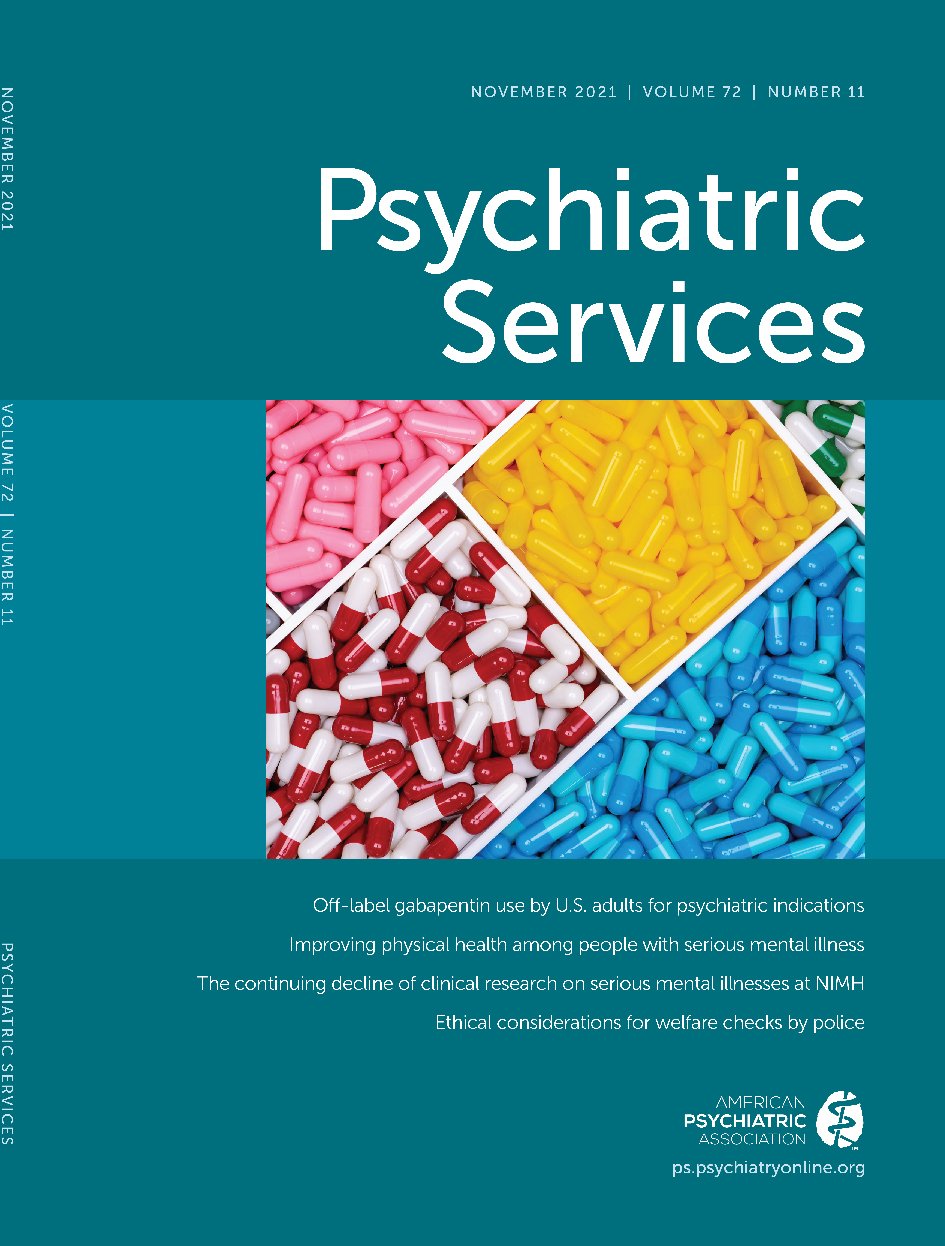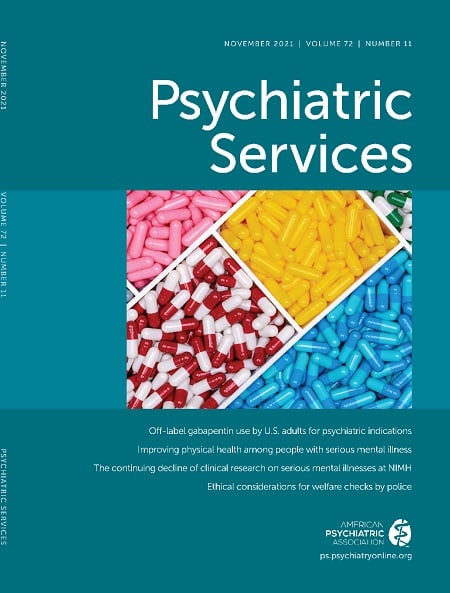The estimated 11.4 million adults with serious mental illness in the United States (
1) have a life expectancy 10 to 20 years shorter, compared with the general population (
2). Much of this premature mortality is attributable to general medical conditions, such as cardiovascular disease and cancer (
2). Despite the high need for both mental health and general medical services among people with serious mental illness, evidence shows that this group often has worse access to and quality of care, compared with people without serious mental illness (
3). In 2018, 36% of adults with serious mental illness did not receive mental health services in the previous year (
1).
The fragmented U.S. specialty mental health and general medical systems are a barrier to achieving “whole person” health care and improving health outcomes among people with serious mental illness. Integrated care models have the potential to address this barrier. Models in which primary care practices deliver or coordinate some mental health services can improve receipt of both mental health care and general medical care and patient outcomes (
4). In the past decade, models in which specialty mental health settings provide or coordinate some general medical services have proliferated. The latter model may be particularly beneficial for people with serious mental illness, who receive a high volume of services in specialty mental health settings (
5).
Maryland, 16 other states, and Washington, D.C., use the Affordable Care Act Medicaid health home waiver to implement behavioral health homes (BHHs) for people with serious mental illness (
6). Maryland uses its waiver to implement BHHs in psychiatric rehabilitation programs (PRPs). The goals of PRPs are to develop independent living skills and promote community integration. They provide services, including case management and assistance with public benefits, and liaise with external providers of somatic and mental health care (
7). Because eligibility criteria for PRPs require that enrollees have significant functional impairment resulting from a serious mental illness (
7), the BHH model allows Maryland to reach a high-need subset of this population.
The limited but growing body of research on BHH programs based in specialty mental health settings has primarily assessed program effects on receipt of primary care services. Findings indicate associations between BHHs and improved quality of general medical and cardiometabolic care (
8), reductions in all-cause emergency department visits (
9), and improvement in quality of life related to physical health (
10). This study examined whether Maryland’s Medicaid BHH program influences receipt of specialty mental health services.
Methods
Maryland Medicaid administrative claims data for 2012 through 2017 were used. Inclusion was limited to participants with serious mental illness ages 21 to 64. To capture engagement with the PRP, participants were included if they had more than five uniquely dated claims for psychiatric rehabilitation services. BHH participants were identified as any person enrolled in a BHH at any time after the program began on October 1, 2013. All participants in PRPs that had a BHH were eligible to enroll in the BHH, and PRP providers reported attempting to enroll all PRP participants; however, they noted that staffing shortages sometimes impeded comprehensive enrollment (
11). For this study, the comparison group consisted of individuals receiving PRP services who were not enrolled in a BHH. Baseline characteristics were calculated by using claims from the year prior to the start of the BHH program.
The unit of analysis was person-time for the 3-month period. We measured the effect of BHH enrollment on outpatient mental health visits by using the number of visits in a 3-month period as the outcome. Outpatient mental health visits were identified by using CPT, HCPCS, and
ICD-9 and
ICD-10 procedure codes, consistent with prior literature (
12), augmented with codes from Maryland’s behavioral health carve-out fee schedule. BHH exposure was measured as dichotomous enrollment (0, not enrolled; 1, enrolled) that switched from 0 to 1 in the quarter in which an individual first enrolled in a BHH. The intention of the BHH model is to enroll and retain individuals. Therefore, we assumed that once enrolled, an individual remained enrolled for the duration of the study period.
PRPs adopted the BHH model throughout the intervention period (October 1, 2013, through December 31, 2016). Of the 54 BHHs operating during the study period, 70% (N=38) started enrollment in the first year of the intervention period. In the second year, 11% (N=6) began enrollment, and 19% (N=10) began enrollment in the last 15 months of the study period.
Given the rolling nature of BHH adoption, we included both time-invariant and preenrollment time-varying covariates, consistent with prior research (
9) Time-invariant covariates included age, sex, race-ethnicity, psychiatric diagnosis, and size of the psychiatric rehabilitation program. Time-varying covariates included eligibility for Medicaid, comorbid substance use disorder diagnosis, Charlson Comorbidity Index score (
13), number of PRP services used, cumulative number of prior inpatient days, number of emergency department visits, number of mental health visits, enrollment in a particular Medicaid managed care organization, and region of residence. Previous qualitative analysis informed our choice of confounders and our commitment to addressing time-varying confounding (
11).
Common causal inference methods (e.g., difference in difference) can introduce bias into estimates of intervention effects when there is time-varying confounding. To address this risk of bias, we used a marginal structural modeling approach with inverse probability of treatment (IPT) weighting (
14). Unlike traditional IPT-weighted difference-in-difference methods, this approach estimates weights for each person–time point in the study period, then fits weighted pooled regression models to estimate effects.
Inverse probability of enrolling in a BHH was estimated at each 3-month period before enrollment on the basis of baseline characteristics and time-varying confounders. After enrollment the IPT is 1. An individual’s IPT weight for a given 3-month period was the product of the IPT in the current period and the IPT for all prior periods. By calculating a weight that is the product of IPTs, the weights adjust for individuals’ history of time-varying and time-invariant confounders up until that time point. To address censoring resulting from Medicaid disenrollment over the study period, we calculated censoring weights by using the same procedures to predict censoring instead of enrollment. Final weights for the 3-month person-time were the product of the IPT and censoring weights. This modeling approach provides estimates of the population average effect, rather than the effect conditional on confounders, which are instead adjusted for via weighting. In this study, we estimated the effect of BHH enrollment on outpatient mental health utilization in a 3-month period by using weights to generate estimates as if the entire population was enrolled versus not enrolled. (Further information on weight calculations can be found in an
online supplement to this report.)
To estimate the effect of BHH enrollment on the number of expected outpatient mental health visits in a given 3-month period, we used weighted negative binomial regression models (see
online supplement). All analyses were conducted in Stata, version 15. This research was considered exempt by the Johns Hopkins School of Medicine Institutional Review Board.
Results
The final sample included 151,408 3-month person-time observations from 12,232 unique individuals. Throughout the study, 14% of individuals (N=1,712) were censored as a result of Medicaid disenrollment, for a loss of 5% of potential observations. Most were censored later in the study period. Of the 12,232 individuals, 3,319 (27%) were enrolled in a BHH, with approximately 68% (N=2,257) enrolling in the first year of the intervention period, 19% (N=631) in the second year, and 13% (N=431) in the last 15 months of the study. A total of 8,913 individuals (73%) were never enrolled in a BHH.
Differences in baseline characteristics between BHH enrollees and nonenrollees indicated the need for weighting. Compared with the nonenrolled group, BHH enrollees were, on average, older and had more comorbid conditions. Additionally, the enrollee group contained a larger proportion of men, White individuals, and individuals with schizophrenia (see table in
online supplement). Weighting improved covariate balance, and the average absolute standardized mean difference of baseline covariate values between the BHH enrolled group and nonenrollees was near or below 20%—a cutoff point used to indicate good covariate balance (see figure in
online supplement) (
14).
BHH enrollment was associated with 0.8 additional mental health visits per 3-month period, with a predicted count of 5.05 visits among nonenrollees versus 5.85 visits among enrollees over the 3-month period (p<0.01) (
Table 1). This 3-month difference translated to 9.3 additional visits for enrollees over the study period (75.17 visits for enrollees versus 65.87 visits for nonenrollees, p<0.01).
Discussion
Our findings are consistent with the results of studies suggesting that BHH programs, which are primarily focused on improving primary care for people with serious mental illness, may also have auxiliary benefits on use of mental health care and outcomes (
8,
10,
15). In a randomized trial of the impact of a BHH at a community mental health center on quality and treatment outcomes for people with comorbid serious mental illness and cardiometabolic risk factors, Druss et al. (
8) found a modestly greater improvement on the 36-item Short Form mental component summary in the BHH group versus control group. A cluster-randomized trial in England by Obsorn et al. (
15) of the cost-effectiveness of an intervention to reduce cholesterol and cardiovascular risk for people with serious mental illness found a reduction of inpatient psychiatric admissions, leading to lower costs in the intervention group. An evaluation of care to improve general medical and psychiatric outcomes for people with bipolar disorder by Kilbourne et al. (
10) at a Veterans Affairs hospital did not find significant differences in psychiatric outcomes, but the authors noted that the small sample may have accounted for the lack of significance in a positive change in mental health quality of life for those in the intervention group.
Previous evaluations of Maryland’s health home waiver suggest that the state’s BHHs are associated with reduced somatic emergency department use and increases in cancer screening; however, no changes were found in quality of cardiovascular care among people with serious mental illness (
9,
16,
17). Maryland’s BHH program is implemented in PRPs. The nature of PRPs may make them especially well suited to the BHH model. In Maryland, PRPs have a history of coordinating mental health treatment that predates implementation of BHHs. Therefore, care managers responsible for tracking general medical care and needs in this setting are also likely to be able to identify additional psychiatric needs and facilitate access to services.
Although primary care–based health homes are typically geared toward increasing access to mental health care, and health homes implemented in specialty mental health settings often prioritize increasing access to primary care, evidence suggests that both models have the potential to increase access to both types of care. This finding may be a result of the employment of similar strategies in both models. For example, care management, shared decision making, and other components of the chronic care model (
18) are used in health home models based in both primary care and specialty mental health care to proactively address patients’ needs and connect patients with appropriate treatment and support.
Our findings should be considered with regard to several limitations. We were not able to determine the clinical appropriateness of the additional outpatient mental health visits or whether they led to improved clinical outcomes. Future research should explore whether this utilization increase differs among subgroups. Our marginal structural modeling analytic approach assumed that there were no unobserved confounders. Maryland’s Medicaid BHH model was implemented in the subgroup of people with serious mental illness who qualify for psychiatric rehabilitation services, which may limit generalizability.
Conclusions
This study of Maryland’s specialty mental health–based BHH program builds on a growing body of integrated care literature suggesting that both primary care–based and specialty mental health care–based models can help to overcome system fragmentation and facilitate “whole person” health care.

